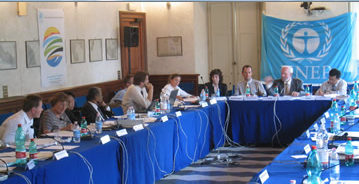|
Recycling Rates Of Metals Report
Recycling Rates of Metals: A Status Report was the 2nd of six scientific assessments on global metals to be published by the International Resource Panel (IRP) of the United Nations Environment Programme. The IRP provides independent scientific assessments and expert advice on a variety of areas, including: • the volume of selected raw material reserves and how efficiently these resources are being used • the lifecycle-long environmental impacts of products and services created and consumed around the globe • options to meet human and economic needs with fewer or cleaner resources. About the report As metal use has increased during the 20th and 21st centuries, there has been a substantial shift from metal resources being subterranean geological stores to becoming ‘above-ground’ stocks in use in society. Metals can be used over and over again, saving energy and minimising the negative environmental impacts associated with mining virgin material, so it makes sense to ... [...More Info...] [...Related Items...] OR: [Wikipedia] [Google] [Baidu] |
International Resource Panel
The International Resource Panel is a scientific panel of experts that aims to help nations use natural resources sustainably without compromising economic growth and human needs. It provides independent scientific assessments and expert advice on a variety of areas, including: * the volume of selected raw material reserves and how efficiently these resources are being used * the lifecycle-long environmental impacts of products and services created and consumed around the globe * options to meet human and economic needs with fewer or cleaner resources. The Secretariat of the IRP is hosted by the United Nations Environment Programme (UN Environment) through its office in Paris, France. Structure of the IRP The Panel has more than 35 expert members drawn from a wide range of academic institutions and scientific disciplines, supported by a small Secretariat hosted by UNEP. It is co-chaired by Janez Potočnik, former European Commissioner for the Environment, and Izabella Teixeira, for ... [...More Info...] [...Related Items...] OR: [Wikipedia] [Google] [Baidu] |
UNEP
The United Nations Environment Programme (UNEP) is responsible for coordinating responses to environmental issues within the United Nations system. It was established by Maurice Strong, its first director, after the United Nations Conference on the Human Environment in Stockholm in June 1972. Its mandate is to provide leadership, deliver science and develop solutions on a wide range of issues, including climate change, the management of marine and terrestrial ecosystems, and green economic development. The organization also develops international environmental agreements; publishes and promotes environmental science and helps national governments achieve environmental targets. As a member of the United Nations Development Group, UNEP aims to help the world meet the 17 Sustainable Development Goals. UNEP hosts the secretariats of several multilateral environmental agreements and research bodies, including The Convention on Biological Diversity (CBD), The Minamata Convention on Mer ... [...More Info...] [...Related Items...] OR: [Wikipedia] [Google] [Baidu] |
United Nations Environment Programme
The United Nations Environment Programme (UNEP) is responsible for coordinating responses to environmental issues within the United Nations system. It was established by Maurice Strong, its first director, after the United Nations Conference on the Human Environment in Stockholm in June 1972. Its mandate is to provide leadership, deliver science and develop solutions on a wide range of issues, including climate change, the management of marine and terrestrial ecosystems, and green economic development. The organization also develops international environmental agreements; publishes and promotes environmental science and helps national governments achieve environmental targets. As a member of the United Nations Development Group, UNEP aims to help the world meet the 17 Sustainable Development Goals. UNEP hosts the secretariats of several multilateral environmental agreements and research bodies, including The Convention on Biological Diversity (CBD), The Minamata Convention on M ... [...More Info...] [...Related Items...] OR: [Wikipedia] [Google] [Baidu] |
Raw Material
A raw material, also known as a feedstock, unprocessed material, or primary commodity, is a basic material that is used to produce goods, finished goods, energy, or intermediate materials that are feedstock for future finished products. As feedstock, the term connotes these materials are bottleneck assets and are required to produce other products. The term ''raw material'' denotes materials in unprocessed or minimally processed states; e.g., raw latex, crude oil, cotton, coal, raw biomass, iron ore, air, lumber, logs, water, or "any product of agriculture, forestry, fishing or mineral in its natural form or which has undergone the transformation required to prepare it for international marketing in substantial volumes". The term ''secondary raw material'' denotes waste material which has been recycled and injected back into use as productive material. Ceramic While pottery originated in many different points around the world, it is certain that it was brought to light mostly ... [...More Info...] [...Related Items...] OR: [Wikipedia] [Google] [Baidu] |
Metal
A metal (from Greek μέταλλον ''métallon'', "mine, quarry, metal") is a material that, when freshly prepared, polished, or fractured, shows a lustrous appearance, and conducts electricity and heat relatively well. Metals are typically ductile (can be drawn into wires) and malleable (they can be hammered into thin sheets). These properties are the result of the ''metallic bond'' between the atoms or molecules of the metal. A metal may be a chemical element such as iron; an alloy such as stainless steel; or a molecular compound such as polymeric sulfur nitride. In physics, a metal is generally regarded as any substance capable of conducting electricity at a temperature of absolute zero. Many elements and compounds that are not normally classified as metals become metallic under high pressures. For example, the nonmetal iodine gradually becomes a metal at a pressure of between 40 and 170 thousand times atmospheric pressure. Equally, some materials regarded as metals ... [...More Info...] [...Related Items...] OR: [Wikipedia] [Google] [Baidu] |
Society
A society is a group of individuals involved in persistent social interaction, or a large social group sharing the same spatial or social territory, typically subject to the same political authority and dominant cultural expectations. Societies are characterized by patterns of relationships (social relations) between individuals who share a distinctive culture and institutions; a given society may be described as the sum total of such relationships among its constituent of members. In the social sciences, a larger society often exhibits stratification or dominance patterns in subgroups. Societies construct patterns of behavior by deeming certain actions or concepts as acceptable or unacceptable. These patterns of behavior within a given society are known as societal norms. Societies, and their norms, undergo gradual and perpetual changes. Insofar as it is collaborative, a society can enable its members to benefit in ways that would otherwise be difficult on an individua ... [...More Info...] [...Related Items...] OR: [Wikipedia] [Google] [Baidu] |
End-of-life (product)
An end-of-life product (EOL product) is a product at the end of the product lifecycle which prevents users from receiving updates, indicating that the product is at the end of its useful life (from the vendor's point of view). At this stage, a vendor stops the marketing, selling, or provisioning of parts, services, or software updates for the product. The vendor may simply intend to limit or end support for the product. In the specific case of product sales, a vendor may employ the more specific term "end-of-sale" ("EOS"). All users can continue to access discontinued products, but cannot receive security updates and technical support. The time-frame after the last production date depends on the product and relates to the expected product lifetime from a customer's point of view. Different lifetime examples include toys from fast food chains (weeks or months), mobile phones (3 years) and cars (10 years). Product support Product support during EOL varies by product. For hardware ... [...More Info...] [...Related Items...] OR: [Wikipedia] [Google] [Baidu] |
Recycling Rate
The following table gives the percentages of municipal waste that is recycled, incinerated, incinerated to produce energy and landfill A landfill site, also known as a tip, dump, rubbish dump, garbage dump, or dumping ground, is a site for the disposal of waste materials. Landfill is the oldest and most common form of waste disposal, although the systematic burial of the waste ...ed. Notes References {{reflist * Energy conversion Waste management ... [...More Info...] [...Related Items...] OR: [Wikipedia] [Google] [Baidu] |






